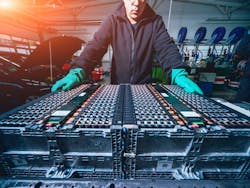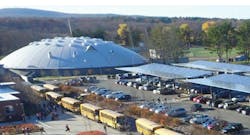Are Second Life EV Batteries Game Changers for Microgrid Owners and the Grid?
Second life electric vehicle batteries can lower costs and provide environmental benefits to microgrid owners and utilities.
But getting them up and running at a reasonable cost isn’t always easy.
Here’s what happens with electric vehicle batteries before they find new lives: They’re generally retired after about 10 years, leaving up to 80% capacity available for other uses, said A.J. Perkins, president of Instant On, which provides microgrids and nanogrids and is now working to include second life batteries in its projects.
The second life batteries are especially useful in stationary storage applications that require less frequent cycling (100-300 cycles per year). If they’re not reused, they must be discarded or recycled, creating environmental challenges.
McKinsey estimates that compared to new batteries, second life batteries are 30% to 70% less expensive.
Multiple benefits of second use
Instant On is working with NICE America Research — an incubator for China Energy that researches clean energy and other ways to move to a low-carbon economy — to put second life batteries to the test with three of Instant On’s pilot projects in multifamily housing, cannabis indoor grow facilities and a gas station microgrid.
“The goal is to show the viability of using second life batteries as they will be lower cost than what we are using in our first life batteries,” said Perkins.
Lower capital costs for microgrids aren’t the only advantage of using second life batteries in microgrids, said Perkins. Microgrid operators gain resiliency, lower utility costs and lower greenhouse gas emissions.
What’s more, when used by utility customers, the batteries can provide benefits to utilities.
“The other beneficiary will be the utilities as they will now have an asset on the customers’ site at the customers’ expense,” said Perkins.
If they take advantage of customer-owned microgrids, the utilities will have access to power during demand response events when the microgrids island from the grid in times of high energy demand. Utilities will also be able to use their customers’ batteries to absorb excess renewable power, Perkins said.
“The utilities will have a virtual power plant that they didn’t have to pay for or allocate land for,” he said.
The microgrids that include second life batteries can also help defer investments in transmission and distribution assets. And behind-the-meter users can use the batteries to take advantage of power arbitrage opportunities by storing renewable power for use during peak times, which provides greater grid flexibility and firming for the grid, said Perkins.
“We believe that we can achieve these savings on CapEx and hope to prove it with these pilots,” he said.
Grading second life electric vehicle batteries
It may seem as if it’s simple to acquire less expensive second life electric vehicle batteries and put them to work in microgrids. But some challenges must be overcome before the batteries can work their magic, said Surinder Singh, director of engineering and the Center of Excellence leader of energy systems solutions for NICE America Research.
The accepted state of health of a second use battery is generally 70% to 80%, he said. They can have higher or lower states of health.
A number of factors affect battery life and state of health, including the type of driver who drove the electric vehicle — aggressive or gentle — and the climate where the vehicle was driven. These factors can degrade the batteries at different rates.
NICE America Research project at Southern Research in Alabama. Photo courtesy of NICE America Research
“In second use batteries, if you start with 300 watt-hours, once the batteries run through their life and retire, some may be 280 watt-hours and some may be 150 watt-hours. Their performance tends to be limited by the less-performing cells in the battery pack,” said Singh. Batteries are grouped in packs within electric vehicles, he explained.
One way to determine the battery’s state of health is to cycle them and give them a grade. These studies often involve disassembling the battery packs.
“Grading them and estimating their state of health involves cost. You spend capital and labor to do that,” he said. This can boost the cost of the second life batteries.
NICE America Research developed a system for grading and evaluating the batteries that’s less expensive. “The key is how we can use the battery packs without disassembly or reassembly. We are spending minimal resources to get a health measurement,” Singh said.
The company buys used batteries and uses its second life battery technology to monitor and manage battery characteristics. “Our management algorithm tunes battery performance using actively monitored data,” said Singh.
What’s next?
The plan is to test NICE America Research’s technology with Instant On’s customers. NICE America will spin the efforts into a new company and commercialize the second life battery technology in 2022.
“It is ready to go. We need to manufacture it at scale; it’s ready for commercialization. But now we need to develop the supply chain and manufacturing,” Singh said.
The top priority is using the second life batteries in microgrids on both sides of the meter with a focus on helping those who are subject to public safety power shutoffs and outages, Singh said.
“This application has the highest potential impact to the grid and utilities,” said Perkins. “If a significant percentage of solar arrays become microgrids or nanogrids, it would be a major game changer.”
Track news about use of second life electric vehicle batteries in microgrids. Subscribe to the free Microgrid Knowledge Newsletter.








